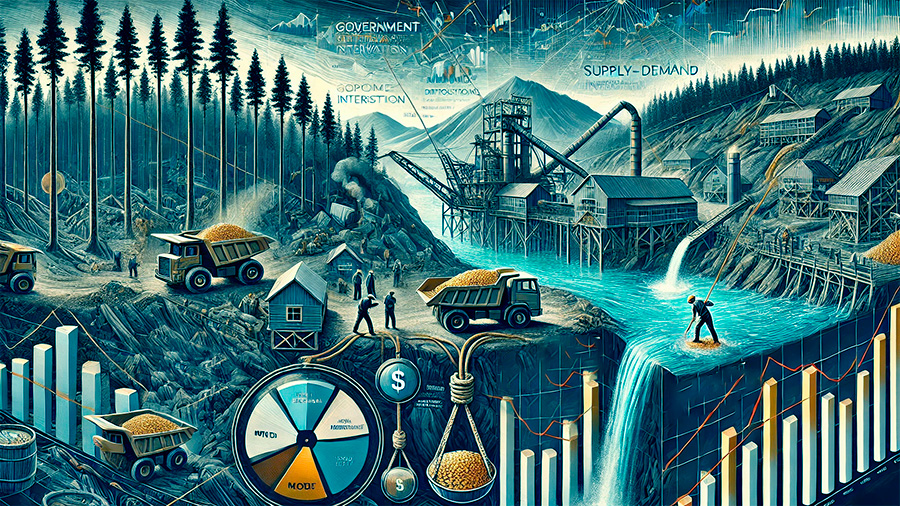
Precious metals like gold, silver, and platinum are not only valuable assets in the global market but also critical components of industries ranging from electronics to renewable energy. As demand for these metals continues to rise, governments around the world play an essential role in stimulating their production. Through various policy measures, such as tax incentives, loans, subsidies, and regulatory adjustments, governments aim to boost the mining and production of these metals, ensuring a steady supply for both domestic and international markets. This article explores the different ways governments stimulate precious metal production and the economic benefits of such efforts.
The Importance of Precious Metal Production
Precious metals are integral to a wide range of industries, from technology and energy to jewelry and finance. They serve as stores of value, act as safe-haven assets during periods of economic instability, and are essential in modern manufacturing processes. Due to their scarcity, mining and production require significant investment in technology, infrastructure, and human resources. This makes it necessary for governments to provide support to ensure that the mining sector remains competitive and can meet global demand.
1. Economic Impact of Precious Metal Production
The mining and production of precious metals contribute significantly to a country’s economy by generating jobs, stimulating trade, and providing revenue through taxes and exports. For many countries, especially those rich in natural resources, the mining industry is a key sector that drives economic growth.
The benefits of precious metal production to national economies:
- Job creation: The mining industry provides direct employment to thousands of workers, from exploration and extraction to refining and distribution.
- Export revenues: Precious metals are highly traded on international markets, contributing to a country’s balance of payments and strengthening its foreign reserves.
- Investment attraction: The mining sector attracts both domestic and foreign investments, particularly in countries with significant mineral resources.

Government Measures to Stimulate Precious Metal Production
Governments employ a variety of policies and measures to encourage the growth of the precious metals sector. These efforts are crucial for enhancing national and global supply chains, reducing dependency on imports, and maintaining economic stability. Below are some of the most common ways that governments support precious metal production.
1. Tax Incentives and Deductions
Tax incentives are one of the most common tools governments use to encourage the exploration and production of precious metals. By offering favorable tax policies, such as deductions for exploration expenses or reduced tax rates on production, governments create an environment that reduces the financial burden on mining companies. This encourages businesses to invest in mining operations and expand production capacity.
Types of tax incentives offered to mining companies:
- Exploration tax credits: Some governments offer tax credits for companies involved in the discovery and exploration of new precious metal deposits, reducing the upfront costs of exploration.
- Reduced mining taxes: Lower tax rates on mining profits or on the sale of extracted metals provide financial relief, increasing profitability and attracting further investments in the sector.
- Depletion allowances: Mining companies may receive deductions for the diminishing value of their mineral reserves over time, which incentivizes further exploration and development.
2. Government Loans and Subsidies
In addition to tax incentives, governments often provide loans or direct subsidies to mining companies to help them expand their operations or fund new projects. These loans are typically low-interest and come with favorable repayment terms, allowing companies to finance the high costs of mining equipment, infrastructure, and research and development.
The role of loans and subsidies in precious metal production:
- Low-interest loans: Governments may offer loans with reduced interest rates to companies involved in the production of precious metals, making it easier for them to invest in advanced mining technology and facilities.
- Subsidies for technology upgrades: Some governments provide financial support for mining companies to adopt more efficient and environmentally friendly technologies, reducing production costs and improving sustainability.
- Research and development funding: Governments may allocate funds for R&D in mining technologies to help companies discover new, more cost-effective ways to extract and refine precious metals.
3. Regulatory Support and Simplified Permitting
One of the most significant barriers to precious metal production is the regulatory and permitting process. Mining projects require numerous permits related to land use, environmental impact, and safety, all of which can take years to obtain. To streamline this process and encourage investment in mining, many governments have simplified regulatory requirements, offering expedited permits and more predictable regulations.
Regulatory measures to stimulate production:
- Streamlined permitting process: Governments can speed up the approval of mining permits, reducing the waiting time for projects to start and helping businesses move forward quickly.
- Environmental regulations: Some governments relax certain environmental restrictions in order to promote production, while others incentivize environmentally sustainable mining practices through tax credits or grants.
- Legal stability: Offering legal protection for mining companies, including property rights and contract enforcement, creates a stable environment that attracts both domestic and foreign investments.
4. Infrastructure Development
Building and maintaining infrastructure, such as roads, ports, and electricity networks, is crucial for the efficient operation of mining companies. In remote regions where many precious metal deposits are located, governments often invest in infrastructure development to reduce transportation and operational costs for mining companies. This makes the production of precious metals more cost-effective and attractive to investors.
The role of government-supported infrastructure development:
- Transportation networks: Governments invest in roads, railways, and ports to facilitate the transportation of raw materials from mining sites to processing plants and international markets.
- Energy provision: Providing access to reliable and affordable energy sources is critical for mining operations, especially for energy-intensive processes such as smelting and refining.
- Water and waste management: Governments may also invest in water supply and waste management infrastructure to support the mining sector and ensure that operations comply with environmental regulations.
5. Promoting Investment in Precious Metals
Governments may also incentivize both domestic and international investment in the mining sector through policies that make investing in precious metals more attractive. These may include policies that provide tax breaks for investors, create a favorable investment climate, and establish precious metal-backed financial products such as exchange-traded funds (ETFs) and futures contracts.
How governments promote investment in the sector:
- Precious metal-backed financial products: Governments can support the development of ETFs or futures contracts that allow investors to gain exposure to the precious metals market, driving demand for mining activities.
- Investment tax incentives: Tax breaks or credits for investments in mining companies encourage both local and foreign investment, which can drive production and exploration efforts.
- Foreign direct investment (FDI) policies: By offering incentives to foreign investors, such as tax exemptions or guarantees on returns, governments can attract capital to develop mining projects in resource-rich countries.

Challenges in Government Intervention in Precious Metal Production
Despite the benefits, government intervention in the precious metal sector comes with its own set of challenges. While support measures such as loans and tax incentives encourage production, they can also lead to inefficiencies, environmental concerns, and market distortions.
1. Environmental Impact
Mining operations can have significant environmental impacts, including deforestation, water pollution, and habitat destruction. While governments offer incentives to boost production, they must also ensure that mining companies adhere to environmental standards and promote sustainable practices.
2. Market Distortions
Heavy government intervention in the precious metals market can sometimes lead to market distortions, where the true supply and demand dynamics are altered. This can result in overproduction, inflated prices, and inefficiencies in the market.
3. Dependence on Government Support
Over-reliance on government support may create an unsustainable dependency for mining companies. If government policies change or funding dries up, mining operations could be left vulnerable, leading to instability in the precious metals market.
Conclusion
Governments around the world play a vital role in stimulating precious metal production through various measures such as tax incentives, loans, subsidies, and regulatory support. These initiatives help mining companies overcome the significant costs and challenges associated with extracting and refining precious metals. By ensuring a steady supply of gold, silver, and other precious metals, governments not only support the broader economy but also help maintain a stable and resilient financial system. However, it is crucial for governments to strike a balance between stimulating production and addressing environmental and market concerns to ensure the long-term sustainability of the precious metals industry.






